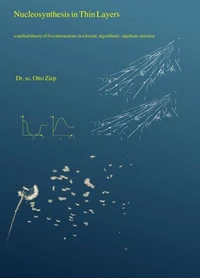Fractal zeta universe and cosmic - ray - charge - cloud superfluid. A unified theory of five interactions in a fractal, algorithmic - algebraic universe
Par :Formats :
Disponible dans votre compte client Decitre ou Furet du Nord dès validation de votre commande. Le format ePub est :
- Compatible avec une lecture sur My Vivlio (smartphone, tablette, ordinateur)
- Compatible avec une lecture sur liseuses Vivlio
- Pour les liseuses autres que Vivlio, vous devez utiliser le logiciel Adobe Digital Edition. Non compatible avec la lecture sur les liseuses Kindle, Remarkable et Sony
 , qui est-ce ?
, qui est-ce ?Notre partenaire de plateforme de lecture numérique où vous retrouverez l'ensemble de vos ebooks gratuitement
Pour en savoir plus sur nos ebooks, consultez notre aide en ligne ici
- Nombre de pages237
- FormatePub
- ISBN978-3-8187-2298-2
- EAN9783818722982
- Date de parution19/11/2024
- Protection num.pas de protection
- Taille2 Mo
- Infos supplémentairesepub
- ÉditeurA PRECISER
Résumé
The trilogy 'Nucleosynthesis in thin layers', 'Fractal zeta universe and cosmic-ray-charge- cloud superfluid', 'The sensitive balance' describes a fractal zeta universe as a new unified theory of strong, weak, electromagnetic, gravitational, and dark interaction. 'Fractal zeta universe and cosmic-ray-charge- cloud superfluid' relates nontrivial zeros of the e.g. Riemann zeta function to charges, atmospheric clouds and cosmic rays.
An oscillating quadrupolar-like potential near zeta function zeros is predicted as a stability region for several phenomena like the quantum Hall conductivity plateau, gravitational waves, sources of creation of matter and a cosmic-ray-charge-cloud superfluid. The large number hypothesis is demonstrated by self-similarity between the Millikan experiment and cosmic-ray cloud seeding. A number-theoretic treatment to the iterated regulator index enables a Lovelock-like expansion into five fields and their coupling constants.
'Nucleosynthesis in thin layers' unifies computer algorithms like a Mandelbrot zoom with algorithms in algebra (iterated hyperelliptic and elliptic theta functions and invariants) and number theory. The presented definition of a bi spinor defines a quantum statistics norm as a bicubic norm. Unified forces are time-thermal rotatory motions of quadrupolar potentials as tidal and dissipation less exchange processes.
Fractal zeta universe and cosmic-ray-charge-cloud superfluid introduces quantized charges as regions near simple zeros of zeta functions.
An oscillating quadrupolar-like potential near zeta function zeros is predicted as a stability region for several phenomena like the quantum Hall conductivity plateau, gravitational waves, sources of creation of matter and a cosmic-ray-charge-cloud superfluid. The large number hypothesis is demonstrated by self-similarity between the Millikan experiment and cosmic-ray cloud seeding. A number-theoretic treatment to the iterated regulator index enables a Lovelock-like expansion into five fields and their coupling constants.
'Nucleosynthesis in thin layers' unifies computer algorithms like a Mandelbrot zoom with algorithms in algebra (iterated hyperelliptic and elliptic theta functions and invariants) and number theory. The presented definition of a bi spinor defines a quantum statistics norm as a bicubic norm. Unified forces are time-thermal rotatory motions of quadrupolar potentials as tidal and dissipation less exchange processes.
Fractal zeta universe and cosmic-ray-charge-cloud superfluid introduces quantized charges as regions near simple zeros of zeta functions.
The trilogy 'Nucleosynthesis in thin layers', 'Fractal zeta universe and cosmic-ray-charge- cloud superfluid', 'The sensitive balance' describes a fractal zeta universe as a new unified theory of strong, weak, electromagnetic, gravitational, and dark interaction. 'Fractal zeta universe and cosmic-ray-charge- cloud superfluid' relates nontrivial zeros of the e.g. Riemann zeta function to charges, atmospheric clouds and cosmic rays.
An oscillating quadrupolar-like potential near zeta function zeros is predicted as a stability region for several phenomena like the quantum Hall conductivity plateau, gravitational waves, sources of creation of matter and a cosmic-ray-charge-cloud superfluid. The large number hypothesis is demonstrated by self-similarity between the Millikan experiment and cosmic-ray cloud seeding. A number-theoretic treatment to the iterated regulator index enables a Lovelock-like expansion into five fields and their coupling constants.
'Nucleosynthesis in thin layers' unifies computer algorithms like a Mandelbrot zoom with algorithms in algebra (iterated hyperelliptic and elliptic theta functions and invariants) and number theory. The presented definition of a bi spinor defines a quantum statistics norm as a bicubic norm. Unified forces are time-thermal rotatory motions of quadrupolar potentials as tidal and dissipation less exchange processes.
Fractal zeta universe and cosmic-ray-charge-cloud superfluid introduces quantized charges as regions near simple zeros of zeta functions.
An oscillating quadrupolar-like potential near zeta function zeros is predicted as a stability region for several phenomena like the quantum Hall conductivity plateau, gravitational waves, sources of creation of matter and a cosmic-ray-charge-cloud superfluid. The large number hypothesis is demonstrated by self-similarity between the Millikan experiment and cosmic-ray cloud seeding. A number-theoretic treatment to the iterated regulator index enables a Lovelock-like expansion into five fields and their coupling constants.
'Nucleosynthesis in thin layers' unifies computer algorithms like a Mandelbrot zoom with algorithms in algebra (iterated hyperelliptic and elliptic theta functions and invariants) and number theory. The presented definition of a bi spinor defines a quantum statistics norm as a bicubic norm. Unified forces are time-thermal rotatory motions of quadrupolar potentials as tidal and dissipation less exchange processes.
Fractal zeta universe and cosmic-ray-charge-cloud superfluid introduces quantized charges as regions near simple zeros of zeta functions.


